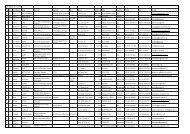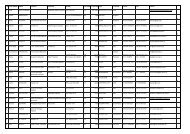icvg 2009 part I pp 1-131.pdf - Cornell University
icvg 2009 part I pp 1-131.pdf - Cornell University
icvg 2009 part I pp 1-131.pdf - Cornell University
Create successful ePaper yourself
Turn your PDF publications into a flip-book with our unique Google optimized e-Paper software.
— 45 —<br />
slightly bigger molecule. Fig. 1 also shows that the<br />
reference Mab GLRaV-4: 3-1-2, reacted with GLRaV-9<br />
SA125 but not with GLRaV-9 LR118 coat proteins. In<br />
IPEM, antibodies from hybridoma culture 62, as well as<br />
from its sub-clones, decorated the filamentous GLRaV-9<br />
SA125 virions (Fig. 2). Antibodies from culture 27, as well<br />
as from its sub-clones, decorated them weakly but caused<br />
their aggregation.<br />
Figure 1. Western blot with antibodies<br />
from hybridoma culture 62 and reference<br />
Mab GLRaV-4: 3-1-2 against homologous<br />
and heterologous GLRaVs (V) isolates<br />
and healthy control extract.<br />
.<br />
Figure 2. IPEM of<br />
GLRaV-9 SA125 virions<br />
decorated by Mab<br />
GLRaV-9: 27-1<br />
Table 2. Identification of the homologous (SA125) and the<br />
heterologous (LR118) GLRaV-9 isolates in crude leaf extracts of<br />
V. vinifera by homologous DAS-ELISA using Mab 27-1 and 62-4<br />
conjugated with alkaline phosphatase. (*: A 405 , mean value of<br />
readings after 2h substrate reaction from 4 distinct samples in<br />
duplicate wells).<br />
4, were then produced at large scale, purified, conjugated<br />
with alkaline phosphatase and further evaluated in DAS-<br />
ELISA.<br />
DAS-ELISA. Both new antibodies conjugated with<br />
alkaline phosphatase and a<strong>pp</strong>lied in DAS-ELISA, using<br />
plates coated with the IgG fraction from rabbit antiserum,<br />
detected the homologous (SA125) and heterologous<br />
(LR118) GLRaV-9 isolates as shown in Table 2.<br />
Conjugates of Mab 27-1 yielded stronger reactions in<br />
DAS-ELISA than those of Mab 62-4. Mab 27-1 crossreacted<br />
with GLRaV-4, GLRaV-5, GLRaV-6 and more<br />
weakly also with GLRaV-7, as shown in Table 3.<br />
CONCLUSIONS<br />
The two new monoclonal antibodies to GLRaV-9 will<br />
be additional new diagnostic tools. Mab 27-1 might be<br />
added to a broad range generic kit for the detection of<br />
GLRaV-4 related viruses, i.e. GLRaV-4, GLRaV-5,<br />
GLRaV-6 and GLRaV-9. Its weak cross-reaction with the<br />
isolate Y276 infected by GLRaV-7 needs further validation<br />
as co-infection with a contaminating GLRaV-4 related virus<br />
could not be ascertained. Mab 62-4 is <strong>part</strong>icularly useful in<br />
Western blot analysis, whereas Mab 27-1 does not react<br />
significantly with denatured coat protein. The results also<br />
demonstrate a significant serological difference between the<br />
Australian and Californian GLRaV-9 isolates which were<br />
intially only identified with molecular tools. Finally,<br />
GLRaV-4, 5, 6 and 9 prove to be closely serologically<br />
related Ampelovirus species or serologically distinct<br />
variants of a species.<br />
LITERATURE<br />
ALKOWNI R., ROWHANI A., DAUBERT S. & GOLINO D. 2004.<br />
Partial characterization of a new ampelovirus associated with<br />
grapevine leafroll disease. Journal of Plant Pathology 86, 123-133.<br />
GUGERLI, P. 1986. Grapevine fanleaf virus. In: Methods of enzymatic<br />
analysis (Bergmeyer, H.U, Ed.). Verlag Chemie, Weinheim FRG Vol<br />
XI, 431-444.<br />
Table 3. Identification of GLRaVs in crude leaf extracts of various<br />
V. vinifera with DAS-ELISA using Mab GLRaV-9: 27-1 and<br />
reference antibody phosphatase conjugates. (A 405 mean values of<br />
readings after 18h substrate reaction from duplicate wells of<br />
typical single leaf sample extracts).<br />
Subcloning by limiting dilution. Hybridoma cultures<br />
27 and 62 were 3, respectively 2 times cloned to yield<br />
monoclonal cultures 27-1-1-5 and 62-4-1. The<br />
corresponding Mabs, simply named Mab 27-1 and Mab 62-<br />
GUGERLI, P., BRUGGER, J. J. & BOVEY, R. 1984. L'enroulement de<br />
la vigne: mise en évidence de <strong>part</strong>icules virales et dévelo<strong>pp</strong>ement<br />
d'une méthode immuno-enzymatique pour le diagnostic rapide.<br />
Revue Suisse de Viticulture, Arboriculture et Horticulture 16, 299-<br />
304.<br />
GUGERLI, P. & RAMEL, M.-E., 2004. Production of monoclonal<br />
antibodies for the serological identification and reliable detection of<br />
a<strong>pp</strong>le stem pitting and pear yellow vein viruses in a<strong>pp</strong>le and pear.<br />
Acta Horticulturae 657, 95-69.<br />
MARTELLI, G.P., AGRANOVSKY, A.A., BAR-JOSEPH, M.,<br />
BOSCIA, D., CANDRESSE, D., COUTTS, R.H.A., DOLJA,<br />
V.V., FALK, B.W., GONSALVES, D, JELKMANN, W.,<br />
KARASEV, A.V., MINAFRA, A., NAMBA, S., VETTEN, H.J.,<br />
WISLER, G.C., & YOSHIKAWA, N. 2002.The family<br />
Closteroviridae revised. Archives of Virology 147, 2039-2044.<br />
PEAKE, B. K., MACKIE, A. E., SIVASITHAMPARAM, K., HABILI,<br />
N. & McKIRDY, S.J. 2004. First report of grapevine leafroll<br />
associated virus 9 (GLRaV-9) in Western Australia. Australasian<br />
Plant Pathology 33, 445-446.<br />
ACKNOWLEDGEMENTS<br />
We thank D. Golino, Davis, U.S.A. for the isolate Helena LR118<br />
and N. Dubuis and J.-J. Brugger for valuable technical help. The study was<br />
<strong>part</strong>ially funded by Bioreba AG.<br />
Progrès Agricole et Viticole, <strong>2009</strong>, Hors Série – Extended abstracts 16 th Meeting of ICVG, Dijon, France, 31 Aug – 4 Sept <strong>2009</strong>




